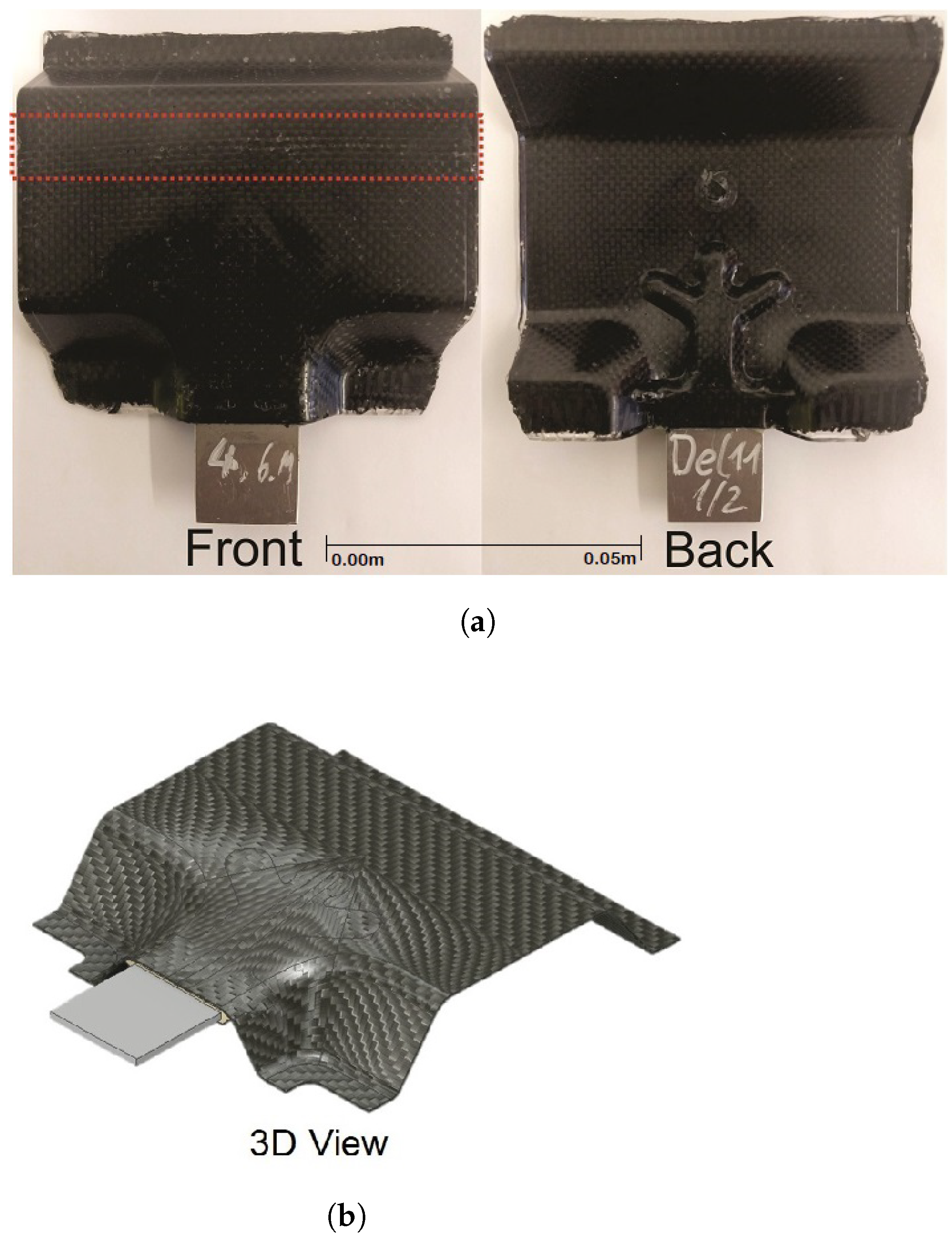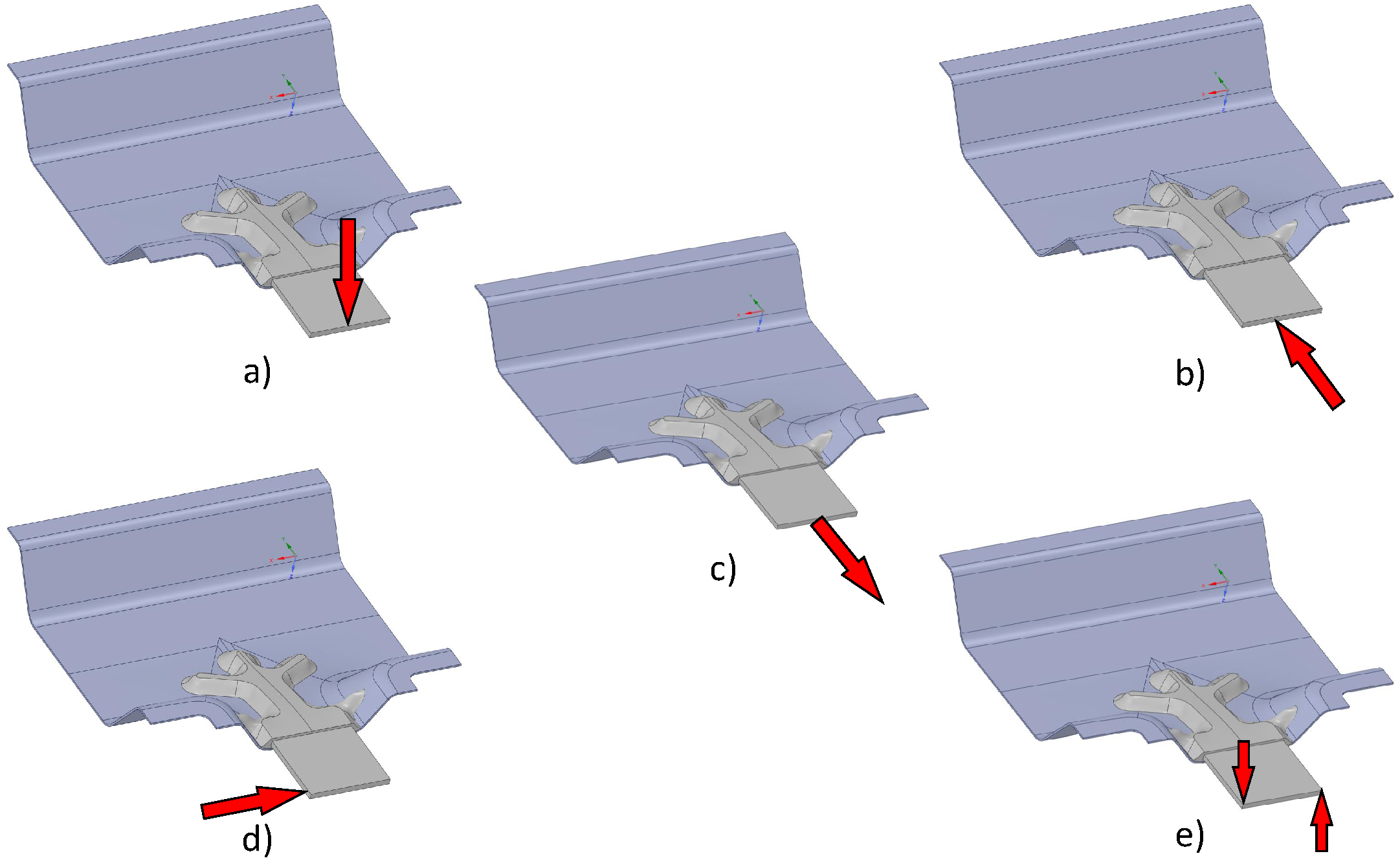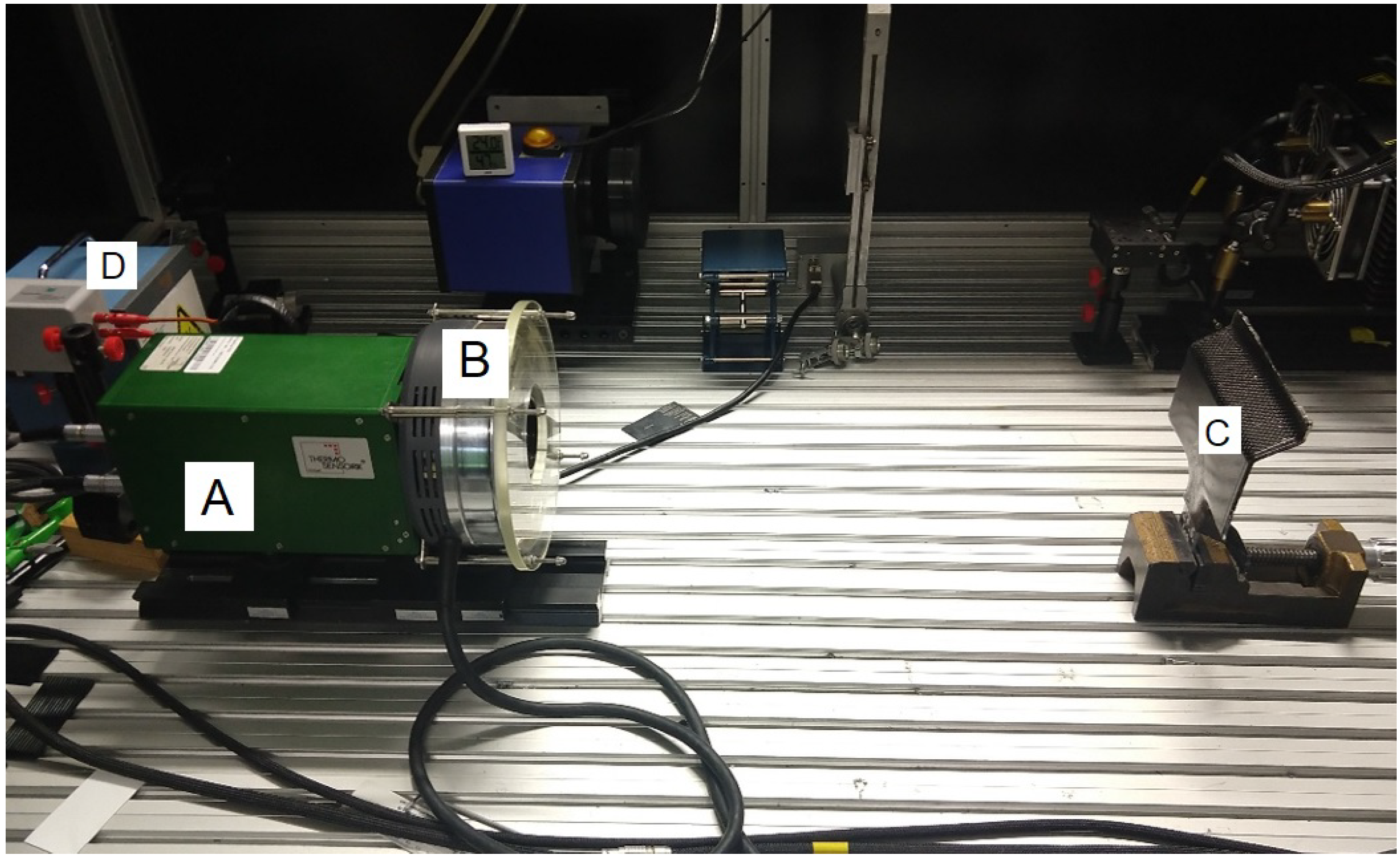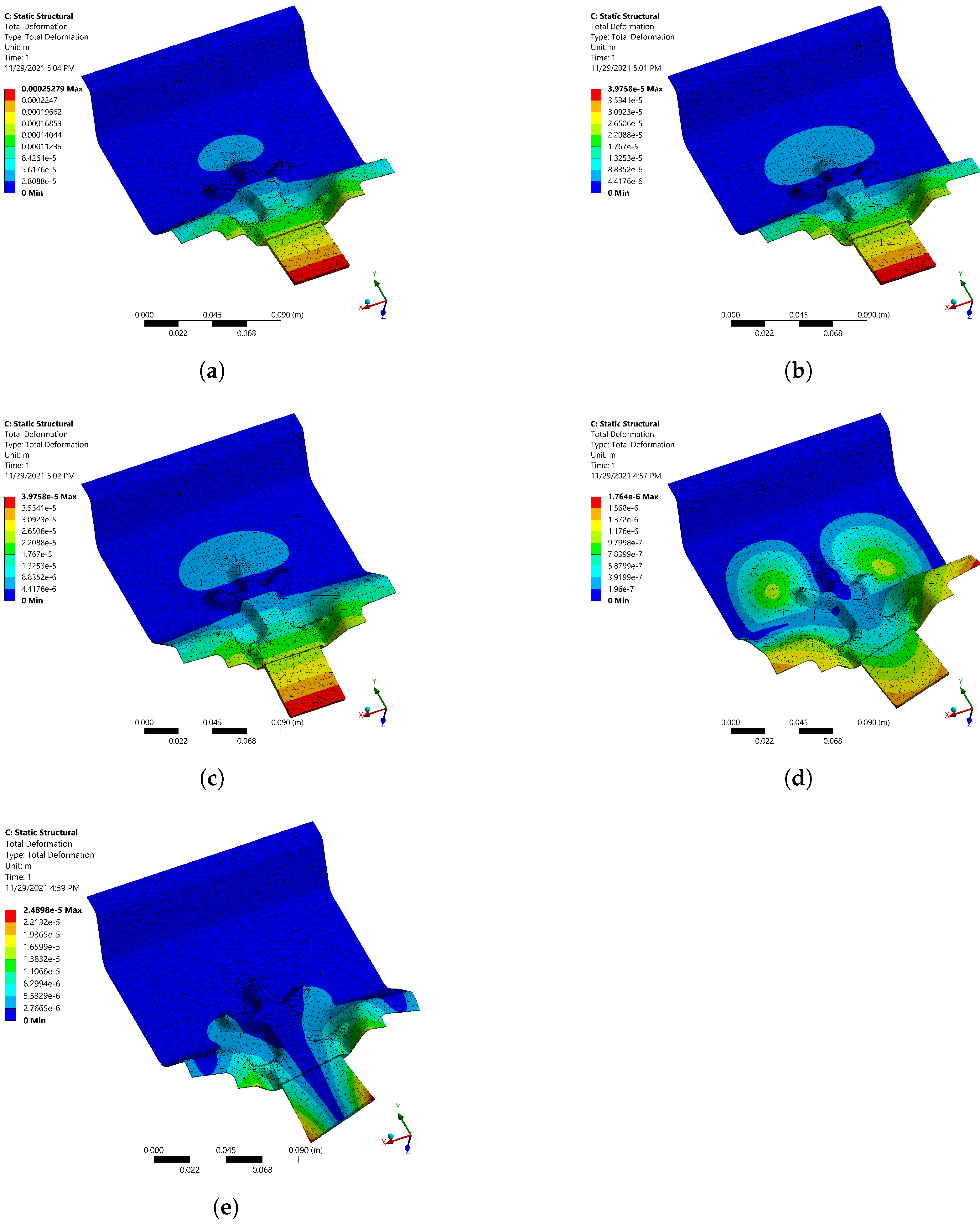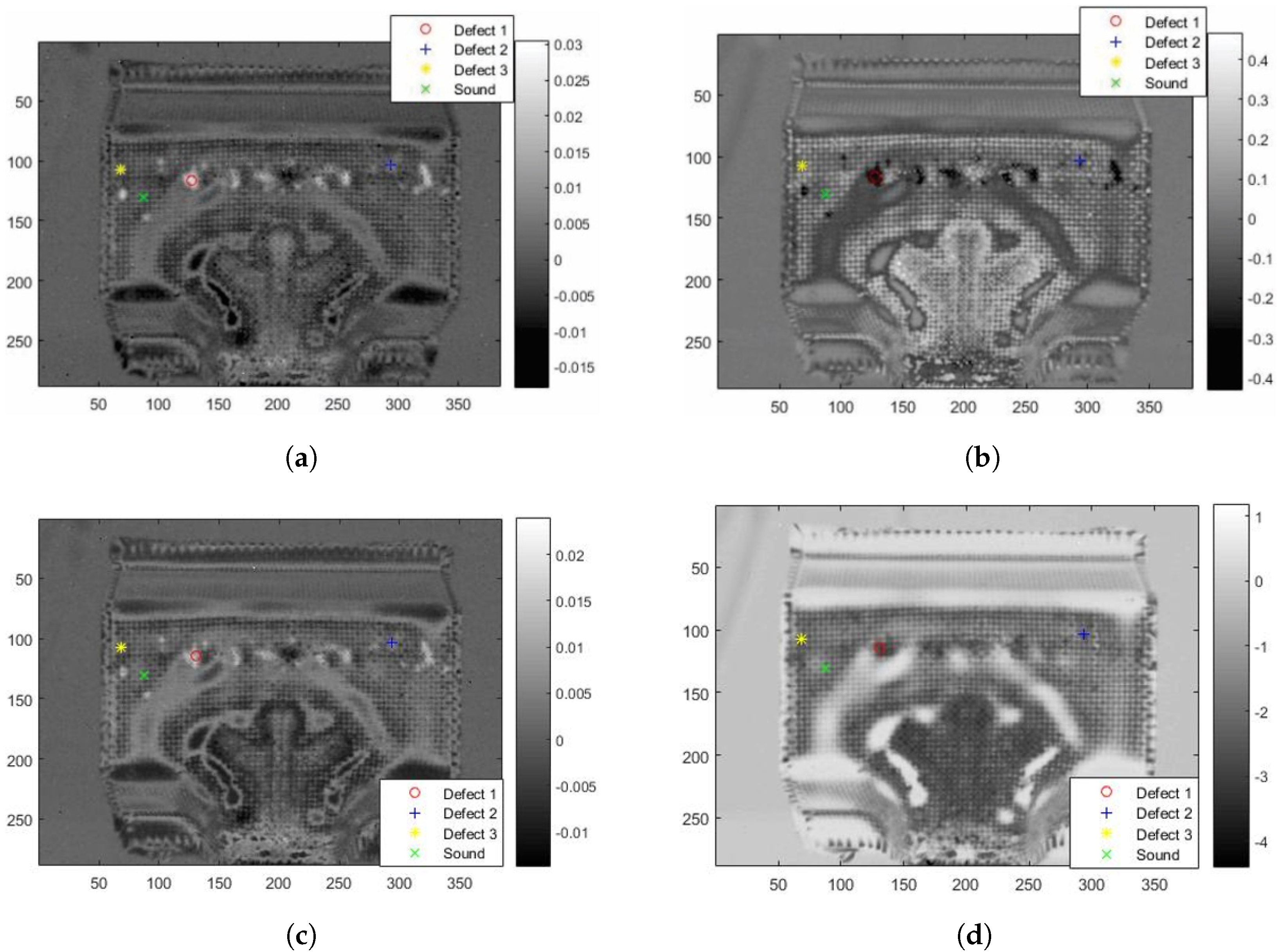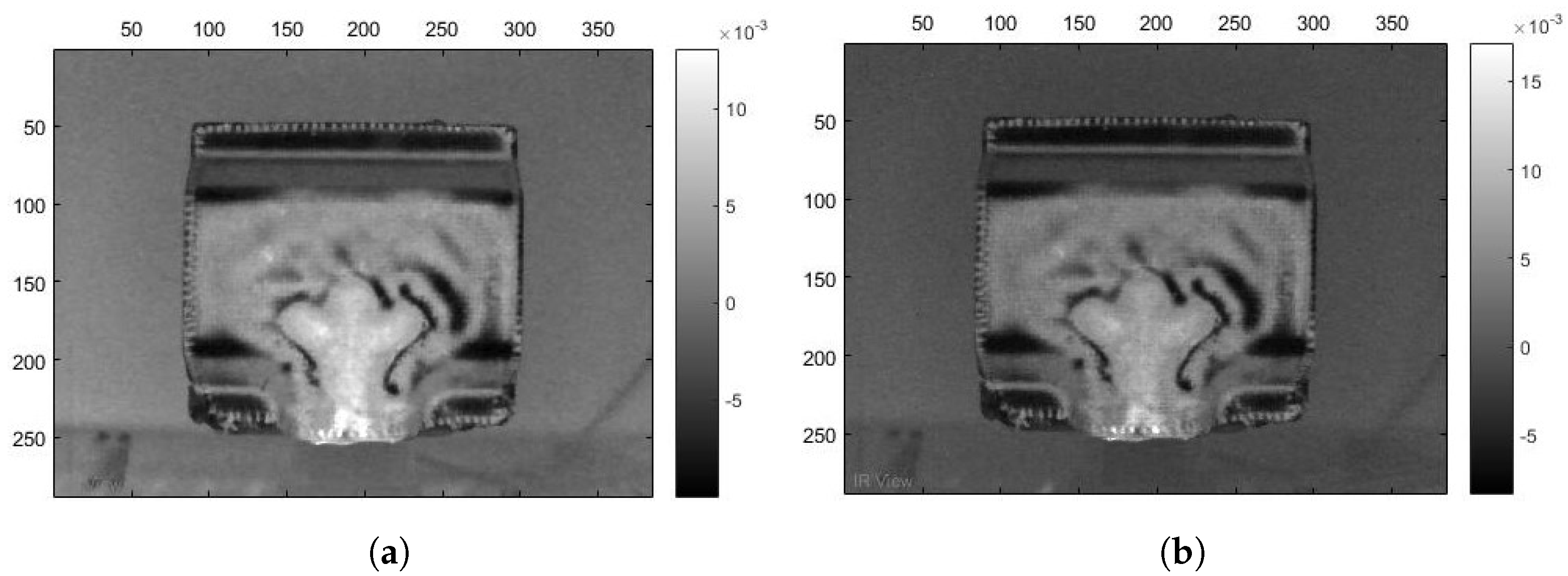1. Introduction
Advanced materials are widely used in aeronautical and automotive industries. Carbon fiber reinforced polymer (CFRP), one of the most used, has excellent specific mechanical properties (i.e., property/density ratio) such as stiffness and strength, as well as relatively high temperature and oxidation resistances. Another advantage is that they are usually lighter than 100% metallic material that have traditionally been used in these industries [
1]. However, to substitute all metal structures by CFRP structures is not a viable option due to the cost factor. Ergo, hybrid structures are typically used in these cases. Here, an aluminum-CFRP hybrid 3D sample is studied. This hybrid is manufactured by injection molding and the aluminum component in the CFRP creates an additional interface where defects are likely to occur. These defects may occur during fabrication or during their life cycle caused by deformation due to mechanical load. It is very important to assess these defects and detect them to guarantee the safety of the advanced structures manufactured with such hybrid materials. In addition, for this sample, an artificial insert was placed prior to molding for academic reasons.
In addition to efficient manufacturing techniques, to ensure the quality of these materials, it is also important to asses their quality and soundness throughout their entire life-cycle. In this sense, non-destructive testing and evaluation (NDT&E) techniques are vital since they guarantee the sample’s integrity after the inspection. Infrared thermography (IRT) is a valuable NDT&E approach usually used to assess different kinds of discontinuities. IRT is a tool broadly used to inspect composite materials for many years now, especially CFRP. It is fast technique, which is non-contact and does not emit any harmful radiation. This topic has been explored extensively with several papers available in the literature.
Yousefi et al. [
2] proposed in their work an improved way for the calculation of the principal component analysis called candid covariance-free incremental principal component thermography (CCIPCT). The method applies a technique for computation of eigen-decomposition of thermographic sequences which ultimately segments the defects in the specimens applying color based K-medoids clustering approach. They tested their approach with CFRP, plexiglas and aluminum specimens. In [
3], Summa et al. introduced a plane hybrid-structure composed of a metal and a CFRP. Further, they used thermography for quantitative damage characterization under quasi-static and fatigue loading of the sample. Meng et al. [
4] used a combination of IRT and 3D structural optical imaging to inspect a curved clad composites with subsurface defects. They presented experimental results that show that their method can reliably inspect and detect defects position in curved parts. In [
5], Zhang et al. used IRT to inspect natural fiber reinforced material. They evaluate and characterize basalt, jute/hemp and bagasse fibers composite panels using pulsed phase thermography (PPT) [
6] and principal component thermography (PCT) [
7]. PPT and PCT are two of the most used data processing techniques used in IRT. Wei et al. [
8] analyzed curved impacted CFRP samples using deep neural networks. They inspected impacted samples and then segment barely visible defects caused by the impact using deep learning methods. Both mid-wave and long-wave spectrum were used in their study. The model trained with mid-wave images achieved an F1-score of 92.74% and the model trained with long-wave images achieved an F1-score of 87.39%.
In this study, IRT is applied to inspect an aluminum-CFRP hybrid 3D sample. This sample was design to be used for the connection between an A- or B-pillar and a car roof made of CFRP. The CFRP has a thermoplastic layer between it and metal component. Additionally, for this specific study, an artificial insert is added to guarantee the presence of internal defects in the sample to enable the quantitative analysis of the data processing techniques that will be used in this work. First, a pulsed thermography (PT) experiment in reflection mode is conducted. Then, a radiometric calibration is performed in the raw data which is acquired with the camera. With the calibrated data, partial least squares thermography (PLST) [
9] (which is based on a statistical correlation method) and principal component thermography (PCT) [
7] (which relies on the single value decomposition method), two processing techniques specifically designed for IRT, are then applied to enhance the obtained PT signal, which is very attenuated and sometimes quite weak due to the transient nature of the heat transfer phenomenon, for better discontinuity (defect or damage) identification. The main advantage, for both techniques, is that they reduce the amount of data to be handled from thousand images (for a single PT experiment) to approximately 5 to 10 images. A quantitative analysis is then performed in the known defective region (artificial insert) via a signal-to-noise ratio comparison to compare and quantify archived results. Finally, a finite element model of the metal-composite-hybrid structure was formulated in ANSYS
® so that it could be possible to investigate the total deformation of the structure subjected to bending, compression, tension, and torsion loads. With this information it is possible to point weak regions in the sample and estimate regions that defects may likely occur during the component life cycle.
4. Discussion
The simulation results shown in
Figure 5 revealed that, for all cases where different forces were applied, the total deformation was concentrated in the interfaces regions between the aluminum inlay the the composite structure as it was expected.
Moreover, IRT results revealed delaminations (parts of the big tape) and voids in the region where the artificial insert was placed. These defects probably occurred due to the resin flow during the molding process. It is worth to mention that the defects in this upper region have no relation to the simulation that were previously performed. IRT results were processed in two different spectral bands. In both bands, i.e., MWIR and LWIR, these delaminations are clearly visible, and, visually, images look alike. However, quantitative analysis performed with SNR comparison of the three randomly picked defects, two out of the three defects showed higher SNR value for the LWIR band. In addition, mean and standard deviation values are also higher for the LWIR images, e.g., when processed with PCT, LWIR results showed a mean value 12.5% higher while the standard deviation was almost three times lower. When one compare results within the spectral bands, but change the image processing technique, PCT showed a better performance in our study case. Nevertheless, both techniques, i.e., PCT and PLST, were capable of qualitatively pointing out the same discontinuities. First loading and first component of PLST and PCT, respectively, are not used because they have the most variation in the transient data, i.e., the flash pulse. Thus, it is highly saturated and does not present the better contrast to distinguish the discontinuities of interest from the background of the sample.
The inspected sample has a rectangular Teflon tape on its upper part. Its exact region is showed in
Figure 1. This tape does not lay perfectly flat on the surface of the composite layer and consequently, it appears that there is no tape in some points. In fact, during molding process, the tape assumes a wavy shape. For the PCT results, bright spots in the tape region are caused by the tape and dark spots are cause by voids that appeared over the tape (air trapped between tape and composite). Bright and dark spots are inverted for PLST results. This behavior is confirmed by CT-Scan inspection of the sample.
Figure 7 shows this wavy behavior and the voids over the tape. In addition, one can observe that, when there is no tape present, there is no defect in the region, as it is confirmed by PCT results of the inspection of another sample which has no tape inserted. These results are shown in
Figure 8. Nevertheless, defects around the inlay aluminum part are also present confirming the results obtained during simulations.
Finally, areas that showed the highest degree of deformation in the numerical model, are likely resin-rich areas. These regions were all around the aluminum inlay. IRT results, in all spectral bands and processed with the two techniques, reveled solid colors in these areas, different to the fibers visible in the rest of the background (sound area) of the sample. Thus, these regions are clearly resin-rich areas. The highest deformation in the simulations occurred in these regions because resin is not the composite constituent that confers resistance to the composite structure, but, the fiber. Once there is no fiber, or, not enough fibers, the regions becomes weak and likely to be a point of failure.
This is a very new design and there are few works in the literature that dealt with this design. Bretz et al. [
15] introduced the optimized design for connecting metal and CFRP. In their work, qualitative assessment was performed using cooperative data fusion of thermography and laser light section. While our work presented and quantitative assessment of artificial defects using infrared thermography, Bretz el al. [
15] performed only a qualitative analysis before, during and after mechanical test of the sample. Jost et al. [
16] also studied a similar hybrid structure. They, as Bretz et al. did, only qualitatively analyzed their results. Jost et al. [
16] performed thermography and EMAT (electromagnetic acoustic transducers) inspections of the sample. Finally, Fernandes et al. [
10] performed thermography inspections of this hybrid sample, but, instead of using PCT and PLST as it was done in the present work, Fernandes et al. [
10] used an unsupervised probabilistic low-rank component factorization model. They also performed a quantitative analysis of detected defects. However, they did not performed a numerical analysis as it was done in this work. The present study is the only one to numerically analyze the deformation of the sample under mechanical forces which could happen during a real use case.
Author Contributions
Numerical model and writing, L.S.S.; experiments, analysis and writing, H.F.; manufacture and calibration, M.S.; co-supervision and revision, H.-G.H.; supervision and revision, A.C. All authors have read and agreed to the published version of the manuscript.
Funding
This research was funded by the Coordenacao de Aperfeicoamento de Pessoal de Nivel Superior—Brazil (CAPES)—Finance Code 001, by Fundacao de Amparo a Pesquisa do Estado Minas Gerais—Brazil (FAPEMIG)—Finance Code APQ-01576-18, and by the Deutsche Forschungsgemeinschaft (DFG) and by the Alexander von Humboldt Stiftung—Germany.
Institutional Review Board Statement
Not applicable.
Informed Consent Statement
Not applicable.
Data Availability Statement
All data generated or appeared in this study are available upon request by contact with the corresponding author.
Conflicts of Interest
The authors declare no conflict of interest.
References
- Richter, J.; Kuhtz, M.; Hornig, A.; Harhash, M.; Palkowski, H.; Gude, M. A Mixed Numerical-Experimental Method to Characterize Metal-Polymer Interfaces for Crash Applications. Metals 2021, 11, 818. [Google Scholar] [CrossRef]
- Yousefi, B.; Sfarra, S.; Ibarra Castanedo, C.; Maldague, X.P. Comparative analysis on thermal non-destructive testing imagery applying Candid Covariance-Free Incremental Principal Component Thermography (CCIPCT). Infrared Phys. Technol. 2017, 85, 163–169. [Google Scholar] [CrossRef]
- Summa, J.; Becker, M.; Grossmann, F.; Pohl, M.; Stommel, M.; Herrmann, H.G. Fracture analysis of a metal to CFRP hybrid with thermoplastic interlayers for interfacial stress relaxation using in situ thermography. Compos. Struct. 2018, 193, 19–28. [Google Scholar] [CrossRef]
- Meng, X.; Wang, Y.; Liu, J.; He, W. Nondestructive inspection of curved clad composites with subsurface defects by combination active thermography and three-dimensional (3D) structural optical imaging. Infrared Phys. Technol. 2019, 97, 424–431. [Google Scholar] [CrossRef]
- Zhang, H.; Sfarra, S.; Sarasini, F.; Santulli, C.; Fernandes, H.; Avdelidis, N.P.; Ibarra-Castanedo, C.; Maldague, X.P.V. Thermographic Non-Destructive Evaluation for Natural Fiber-Reinforced Composite Laminates. Appl. Sci. 2018, 8, 240. [Google Scholar] [CrossRef] [Green Version]
- Maldague, X.; Marinetti, S. Pulse phase infrared thermography. J. Appl. Phys. 1996, 79, 2694–2698. [Google Scholar] [CrossRef]
- Rajic, N. Principal component thermography for flaw contrast enhancement and flaw depth characterisation in composite structures. Compos. Struct. 2002, 58, 521–528. [Google Scholar] [CrossRef]
- Wei, Z.; Fernandes, H.; Herrmann, H.G.; Tarpani, J.R.; Osman, A. A Deep Learning Method for the Impact Damage Segmentation of Curve-Shaped CFRP Specimens Inspected by Infrared Thermography. Sensors 2021, 21, 395. [Google Scholar] [CrossRef] [PubMed]
- Lopez, F.; Ibarra-Castanedo, C.; de Paulo Nicolau, V.; Maldague, X. Optimization of pulsed thermography inspection by partial least-squares regression. NDT E Int. 2014, 66, 128–138. [Google Scholar] [CrossRef]
- Fernandes, H.; Zhang, H.; Quirin, S.; Hu, J.; Schwarz, M.; Jost, H.; Herrmann, H.G. Infrared thermographic inspection of 3D hybrid aluminium-CFRP composite using different spectral bands and new unsupervised probabilistic low-rank component factorization model. NDT E Int. 2022, 125, 102561. [Google Scholar] [CrossRef]
- Quirin, S.; Herrmann, H.G. Combining the spectral information of Dual-Band images to enhance contrast and reveal details. In Proceedings of the 14th International Conference on Quantitative Infrared Thermography 2018, (QIRT 2018), Berlin, Germany, 25–29 June 2018; Creative Commons (QIRT Council): Québec, QC, Canada, 2018; pp. 779–785. [Google Scholar] [CrossRef]
- Quirin, S. Multispektraler Ansatz zur Verbesserung der thermografischen Prüfbarkeit von Werkstoffverbunden. Ph.D. Thesis, Saarländische Universitäts und Landesbibliothek, Saarbrucken, Germany, 2020. [Google Scholar] [CrossRef]
- Hidalgo-Gato García, R.; Andrés Álvarez, J.R.; López Higuera, J.M.; Madruga Saavedra, F.J. Quantification by Signal to Noise Ratio of Active Infrared Thermography Data Processing Techniques; Scientific Research Publishing: Wuhan, China, 2013. [Google Scholar] [CrossRef]
- Albendea, P.; Madruga, F.; Cobo, A.; López-Higuera, M. Signal to noise ratio (SNR) comparison for pulsed thermographic data processing methods applied to welding defect detection. In Proceedings of the 10th International Conference on Quantitative Infrared Thermography 2010, (QIRT 2010), Quebec City, QC, Canada, 27–29 July 2010; Creative Commons (QIRT Council): Québec, QC, Canada, 2010; pp. 27–30. [Google Scholar]
- Bretz, L.; Günther, F.; Jost, H.; Schwarz, M.; Kretzschmar, V.; Pohl, M.; Weiser, L.; Haefner, B.; Summa, J.; Herrmann, H.; et al. Design and quality assurance of intrinsic hybrid metal-CFRP lightweight structures. In Proceedings of the 4th International Conference Hybrid Materials and Structures (Hybrid 2020), Web-Conference, Karlsruhe, Germany, 28–29 April 2020; pp. 144–156. [Google Scholar]
- Jost, H.; Schwarz, M.; Grossmann, F.; Sauer, J.; Hell, A.; Herrmann, H.G. Nondestructive and Destructive Testing on Intrinsic Metal-CFRP Hybrids. In Technologies for Economic and Functional Lightweight Design; Dröder, K., Vietor, T., Eds.; Springer: Berlin/Heidelberg, Germany, 2021; pp. 279–289. [Google Scholar] [CrossRef]
| Publisher’s Note: MDPI stays neutral with regard to jurisdictional claims in published maps and institutional affiliations. |
© 2021 by the authors. Licensee MDPI, Basel, Switzerland. This article is an open access article distributed under the terms and conditions of the Creative Commons Attribution (CC BY) license (https://creativecommons.org/licenses/by/4.0/).
